Human resources, which are the basis for supporting scientific and technological activities, will be discussed here. In this chapter, R&D personnel, and more specifically, the status of researchers and research assistants in Japan and in selected countries will be explained. Concerning the present available data on the number of researchers, there are differences in definition of a researcher, and the methods of measurement applied are not unified across each country. Therefore, it could be said that this data is not suitable for strict international comparison. But even so, this data can be used to understand the condition of R&D personnel in each country if it is born in mind that there are differences in the scopes and levels of researchers in each country.
2.1 International comparison of the number of researchers in each country
Key points
- The number of researchers in Japan's public organizations in 2013 was 650,000. Using the actual number (head count; HC) method, the number was about 890,000. Japan ranks third behind China and the U.S. in the number of researchers.
- Comparing the number of researchers by sector, the business enterprises sector had the largest share. In Korea, this percentage was 80%. It was 70% in Japan and the U.S., and 60% in Germany, France, and China. However, in the U.K., the universities and colleges sector accounts for a larger share with 60% of the total.
- Looking at the percentage of Japanese researchers who hold doctoral degrees, in 2013 it was 20.8% for all researchers. By sector, the percentage was highest in the universities and colleges sector, at 56.7% in 2013. It was followed by the public organizations sector at 44.8%. The trend is rising in both sectors.
- Looking at the percentage of researchers who held doctoral degrees in Japanese and US business enterprises in 2010, the percentage was 4% in Japan and 13% in the U.S.
- The ratio of female researchers in Japan is large in the “universities and colleges” sector but low in the “business enterprises” sector.
- The number of female students enrolling in Japanese universities is growing.
2.1.1 Methods for measuring the number of researchers in each country
According to the Frascati Manual issued by the OECD, “researchers” are defined as “professionals engaged in the conception or creation of new knowledge, products, processes, methods, and systems and engaged also in the management of the projects concerned(1).”
To measure the number of researchers, similar to the method adapted to measure R&D expenditure, a questionnaire survey is used in general, but for some sectors in some countries data obtained from other survey is used. In addition, there are two kinds of methods used to measure the number of researchers. One method is to measure the research work by converting it into “full-time equivalents” (FTE).(2) In this case, R&D activities are separated from other activities and the number of hours engaged in actual R&D activity is used as the basis for measuring the number of researchers. This method is widely accepted internationally as one which measures the number of researchers by taking their activities into account while counting them.(3)
The other method is to classify all activities as R&D activities, even when the research content of work is combined with other activities, and to measure the number of researchers according to the actual number found by head counting (HC).
Chart 2-1-1 shows the definition and measurement method of researchers for 4 sectors which are the same as the performing sectors of R&D expenditure in each country (The data for each country was measured by FTE conversion. Whenever HC value is used, a notation of this is provided). All the countries conduct their measurements of researcher numbers according to the questionnaire survey as indicated in the Frascati Manual issued by the OECD and based on its definition of researchers. However, in some sectors, questionnaire surveys were not performed or the FTE value measurements were not carried out; this caused the differences among countries and sectors. In particular, differences can be seen according to the country regarding the measurements of the number of researchers working in the universities and colleges sector.
In Japan, the number of researchers has been measured in R&D statistics (Survey of Research and Development) by the Ministry of internal affairs and communications. But it was not until 2002 that the FTE method was introduced to measure researchers. Numbers of researchers in Japan were shown in terms of the three measuring methods provided below for the target periods (Chart 2-1-2).
Chart 2-1-2 (A) shows the measurement method used until 2001, which was neither FTE nor HC. Here, the number of people checked with a circle in Column (1) was counted as the number of researchers.
The measurement methods for 2002-2007 are shown in Chart 2-1-2 (B). Here, the number of researchers is obtained by counting the number of people in the column for researchers by means of FTE if the corresponding cell in Column (2) is checked. It is obtained by HC if the corresponding cell in Column (3) is checked.
Since 2008, the FTE coefficient obtained through new FTE surveys is used (Chart 2-1-2 (C)).
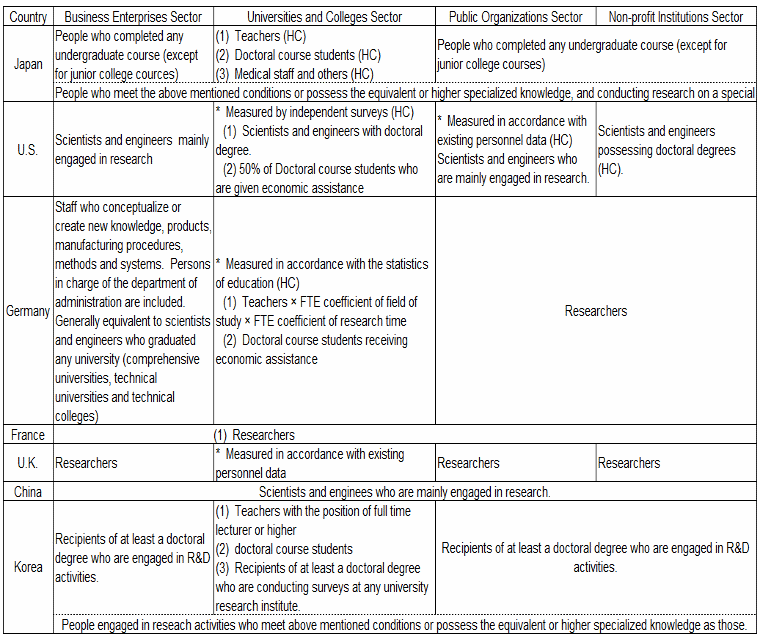
Note:
1) The data is in accordance with statistical surveys of R&D except for data marked with*which is obtained from a source other than statistical surveys of R&D.
2) Measurements are conducted on the basis of FTE in statistical surveys of R&D in each country. The cases in any sector in which FTE is not adopted are marked with (HC).
3) (2) Expression “doctoral course student” in the universities and colleges sector in Japan represents those in the later term (the 3rd to 5th year).
4) With regard to the universities and colleges sector in the U.S., the FTE of researchers is obtained by adding (1)50% of doctoral course students who are financially assisted.
5) In Germany, the public organizations sector and the non-profit institutions sector are combined. With regard to the universities and colleges sector, the FTE of researchers is obtained by multiplying the HC of teachers by FTE coefficients.
6) Expression solely used “researchers” represents that any definition and measurement method of researchers was not obtained in the sector.
7) For the U.S., the counting method used through 1999 is applied.
Source:
NISTEP, “Metadata of R&D-related statistics in selected countries: Comparative study on the measurement methodology” (Research Material No. 143)
Ministry of Internal Affairs and Communications, “Report on the Survey of Research and Development”
(A) Until 2001
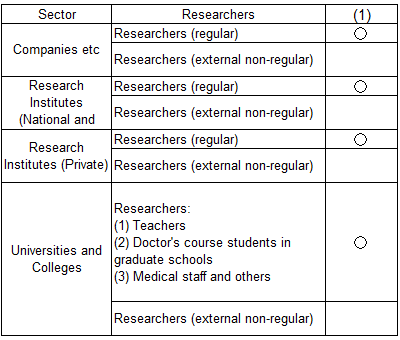
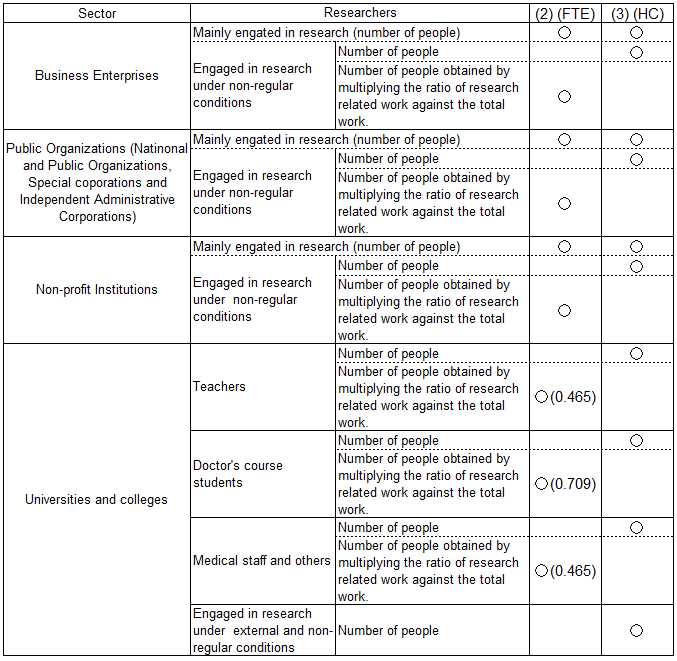
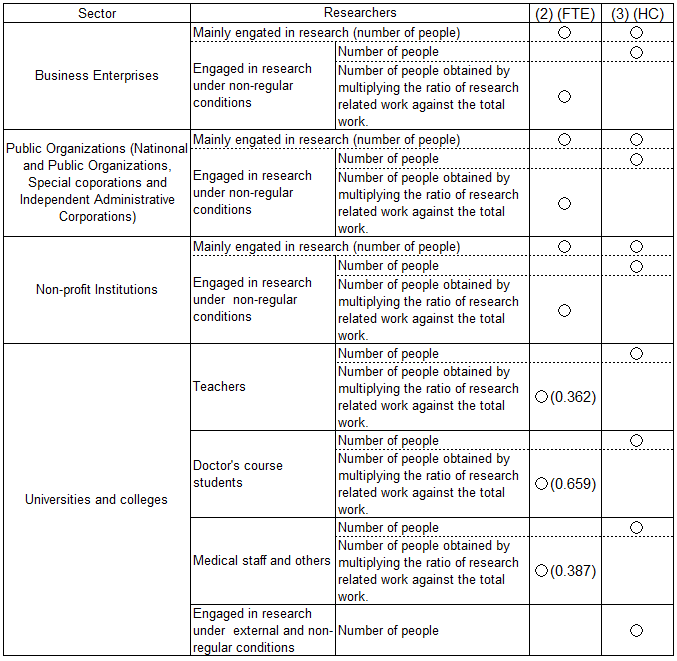
Note:
1) (1) “People mainly engaged in research” not converted on R&D basis until 2001. (2) “People mainly engaged in research” and “people who are engaged in research under external and non-regular conditions and converted to FTE (FTE)” since 2002. (3) “People mainly engaged in research” and “people engaged in research under external and non-regular conditions (HC)” since 2002.
2) Values for the universities and colleges sector are FTE coefficients. An FTE is obtained by multiplying the corresponding number of people by a FTE coefficient.
(1) 2002-2007: The results of the “Survey on the data for full-time equivalents in universities and colleges” conducted by MEXT in 2002 are used. For “medical staff and others” , the same FTE coefficient as for “teachers” is used.
(2) 2008-: The results of the “Survey on the data for full-time equivalents in universities and colleges” conducted by MEXT in 2008 are used.
Source:
Ministry of Internal Affairs and Communications, “Report on the Survey of Research and Development”
2.1.2 Trends in the numbers of researchers in each country
The number of researchers in Japan's public organizations in 2013 was 650,000. Using the actual number (head count; HC) method, the number was about 890,000. Japan ranks third behind China and the U.S. in the number of researchers. In 2008, Japan converted to using FTE to calculate the number of researchers. The continuity of FTE figures between 2007 and 2008 is therefore impaired.
The number of researchers in the U.S. is an estimate by the OECD. It was publicly announced only up to 1999 for the universities and colleges, and up to 2002 for the public organizations sector and the non-profit institutions sector. Numbers for the business enterprises sector have been publicly announced since 2008.
In Germany, statistical surveys for R&D are conducted in the business enterprises sector, the public organizations sector and the non-profit institutions sector. With regard to the universities and colleges sector, however, the measurement is in accordance with the statistics on education, and the FTE value of researchers is measured using full time equivalent coefficients by academic field of study. Because the 1990 unification of East and West Germany increased the number of researchers in 1991, data continuity is impaired.
In France, the number of researchers is measured in accordance with statistical surveys for R&D which are conducted in all the sectors.
In the U.K., because no statistical survey for R&D is conducted in the universities and colleges sector, the total number of researchers had been calculated from 1999 using the estimates by the OECD. Recently, however, the U.K. has begun publishing the number of researchers in the sector. Figures have been available since 2005.
China publishes R&D statistics, but details of its statistical surveys are unknown. In 2009, it began using the definitions in the OECD's Frascati Manual to collect statistics. This resulted in a big drop from the 2008 figure.
Korea conducts statistical surveys for R&D by sector. Through 2006, however, the target was limited to the “field of natural science and engineering” . Since 2007, all fields have been covered. Therefore this condition should be born in mind. Since 2010, Korea has surpassed France and the U.K.


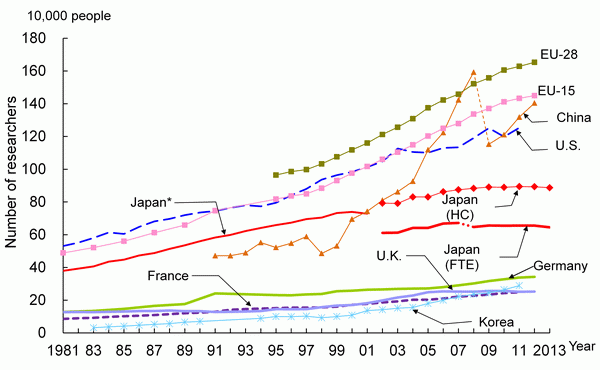
Note:
1) The number of researchers in a country represents the total value of researchers in every sector, and the definition and measurement method for researchers in each sector is occasionally different depending on the country. Therefore it is necessary to be careful when international comparisons are being made. See Chart 2-1-1 for details on differences in the definition of “researcher” among the countries.
2) Values for each country are FTE, except Japan, which showed both FTE and HC values.
3) The values include the number of researchers in the field of social sciences and humanities (until 2006, only that of the field of natural science and engineering for Korea).
<Japan>
(1) Values until 2001 represent the numbers of researchers measured on Apr.1 and since 2002 represent the numbers of researchers measured on Mar.31 in the corresponding year, respectively.
(2) “Japan*” represents the values in Chart 2-1-2(A)(1).
(The number of “people mainly engaged in research” without being converted on FTE basis. External non-regular researchers are not measured.)
(3) “Japan (HC)” represents the values in Chart2-1-2(B)(2). (The total of “people mainly engaged in research” and “people engaged in research under non-regular conditions” . The number of researchers in the universities and colleges sector includes the above mentioned “external non-regular researchers” ).
(4) The FTE values of “Japan” through 2007 represent the values in Chart2-1-2(B).
(The measurement for the universities and colleges sector is made with the conversion in accordance with the results of the “Survey on the data for full-time equivalents in universities and colleges” in 2002. With regard to the business enterprises sector, the public organizations sector and the non-profit institutions sector, “people mainly engaged in research” and “people engaged in research under non-regular condition whose values are converted on FTE basis” are measured.)
(5) FTE values for “Japan” from 2008 on are those shown in Chart 2-1-2 (C).
(The value for the ““universities and colleges” calculated using the 2008 “Survey on the data for full-time equivalents in universities and colleges,” and for ““business enterprises” and “public organizations and non-profit institutions” count ““people mainly engaged in research” and “people engaged in research under non-regular condition whose values are converted on FTE basis.” )
<U.S.> OECD Secretariat estimate/projection based on each country's materials.
<Germany> Until 1990, data is for the former West Germany. After 1991, data is for the unified Germany. For 2010 and 2012, OECD Secretariat estimate/projection based on each country's materials. Figures for 2012 are provisional.
<U.K.> OECD secretariat estimate or projection based on national sources has been used since 1999. In 2005, the measurement method was changed to use of national projections or estimated values Figures for 2012 are provisional.
<China> Through 2008, the definition of researcher used was not in complete accordance with the OECD. The measurement method was changed in 2009. Caution is therefore necessary when observing changes over time.
<EU> OECD Secretariat estimate/projection based on each country's materials.
Source:
<Japan> Ministry of Internal Affairs and Communications, “Report on the Survey of Research and Development “; MEXT, “Survey on the data for full-time equivalents in universities and colleges” (2002 and 2008)
<U.S. France, U.K., China, and EU> OECD, “Main Science and Technology Indicators 2013/2”
<Germany> Bundesministerium fur Bildung und Forschung, “Bundesbericht Forschung 1996, 2000, 2004” ; “Forschung und Innovation in Deutschland 2007” “Bundesbericht Forschung und Innovation, 2008, 2010, 2012” ; OECD, “Main Science and Technology Indicators 2013/2” since 2010.
<Korea> KISTEP, Statistical DB (website)
Next, an international comparison is conducted in which the influence of the size of each country is reduced by using the relative value of the number of researchers, in other words, the number of researchers per capita (Chart 2-1-4). Looking at values since 2002, values for Japan (FTE) have been higher than those of the U.S., but they have been overtaken by Korea's in recent years. It should be noted that the FTE coefficient for researchers that is used for Japan's FTE value was changed from 2007 to 2008, and thus FTE value continuity is impaired.
The growth rate has been highest of all in Korea. It has been especially remarkable since 2004. European countries have shown a gradual increase over the long term.
Moreover, like the number of researchers per capita, Japan's values are high in terms of the number of researchers per labor force (Chart 2-1-5), however these values have been surpassed by Korea's in recent years. As for rate of growth, although it appears that there is little difference in movement between the number of researchers per labor force and number of researchers per capita among most of the countries, the former for France is larger than in other European countries.


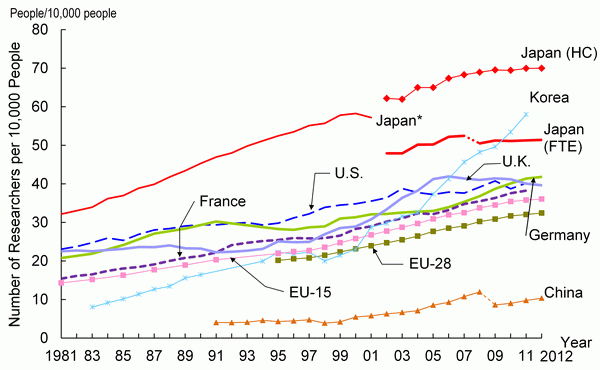
Note:
Refer to Chart 2-1-3 for notes on “attention to international comparison,” “attention to trend,” and number of researchers. The population is the same as for Reference Statistics A.
Source:
Chart 2-1-3; The population is the same as for Reference Statistics A.


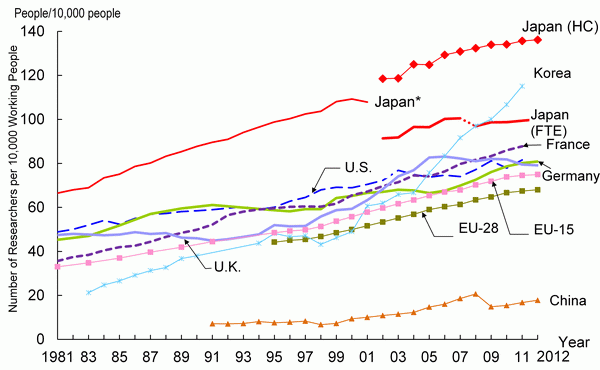
Note:
Refer to Chart 2-1-3 for notes on “attention to international comparison,” “attention to trend,” and number of researchers. The labor force is the same as for Reference Statistics B.
Source:
Chart 2-1-3; The population is the same as for Reference Statistics B.
2.1.3 Trends in the proportion of the number of researchers by sector in each selected country
(1) Breakdown of each country's researchers by sector
The situation and trend over time with regard to the number of researchers in each country are examined by sector, which are same as those in the classification of R&D expenditure, the “business enterprises sector” , the “universities and colleges sector” , the “public organizations sector” and the “non-profit institutions sector” .
Although an international comparison of the number of researchers faces difficulties as mentioned in 2.1.1, in this section each country's characteristics are examined using the data which is available at the present time.
In almost all of the countries, a large percentage of researchers was in the business enterprises sector. In Korea, this percentage was 80%. It was 70% in Japan and the U.S., and 60% in Germany, France, and China. However, in the U.K., the universities and colleges sector accounts for a larger share with 60% of the total. This same sector accounts for about 20% in Japan and China and around 30% in Germany and France. As for the public organizations sector, the largest share is in China, where it accounts for 20% of the total (Chart 2-1-6).
Next, a look at by-sector trends in the number of researchers (Chart 2-1-7) shows that Japan has trended flat in all sectors in recent years. The numbers of researchers in the U.S. are estimates by the OECD. Given that data for sectors outside the business enterprises sector have been unavailable in recent years, values are provided from 2008. In Germany, the number began to increase from the mid-2000s, with a particularly strong increase in the universities and colleges sector. In France, growth in the business enterprises sector has been remarkable since entering the 2000s. In the U.K., there has been little change in any of the sectors since the mid-2000s. In 2009, China began using the definitions in the OECD's Frascati Manual to collect statistics. This resulted in a big drop from the 2008 figure. In Korea, growth in the business enterprises sector has been substantial since entering the 2000s.

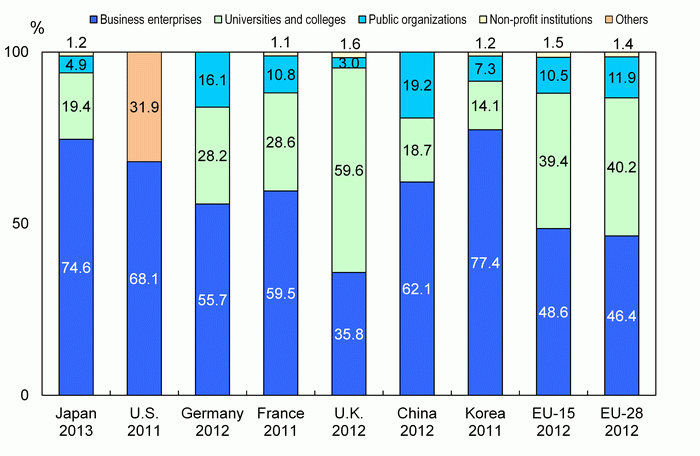
Note:
1) Values for each country are FTE.
2) Data of the field of social sciences and humanities were also included.
3) The values in the non-profit institutions sector for each country (other than Japan) were obtained by subtracting the number of researchers in the business enterprises sector, the universities and colleges sector and the public organizations sector from the total.
<Germany> Public organizations include non-profit institutions. Data for the year appearing in the chart are national projections or estimated/provisional values.
<U.K.> Data for the year appearing in the chart are national projections or estimated/provisional values.
<EU> Data for the year appearing in the chart are OECD Secretariat estimates/projections based on each country's materials.
Source:
<Japan> Ministry of Internal Affairs and Communications, “Report on the Survey of Research and Development “; MEXT, “Survey on the data for full-time equivalents in universities and colleges” (2002 and 2008)
<U.S., Germany, France, U.K., China, and Korea> OECD, “Main Science and Technology Indicators 2012/2”

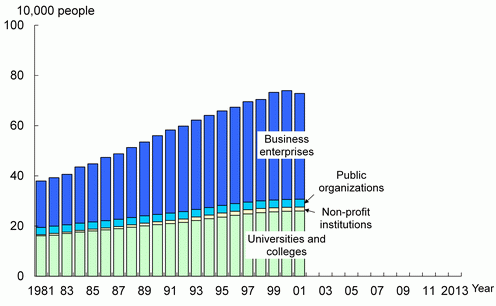
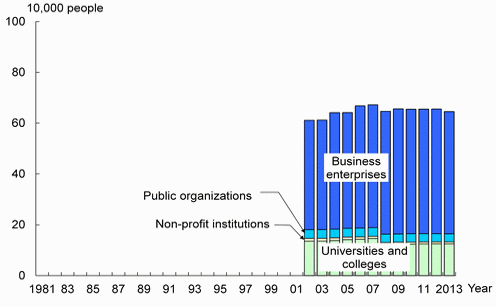
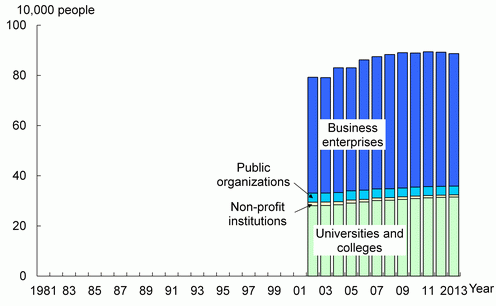
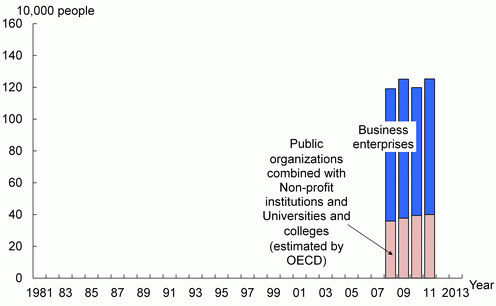
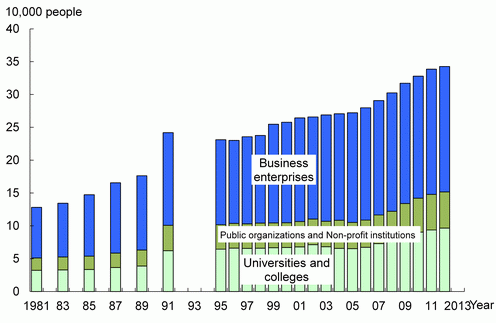
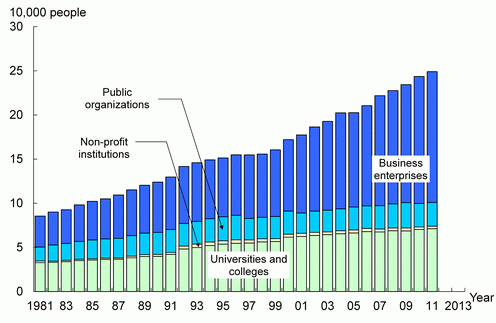
 (G) U.K.
(G) U.K.
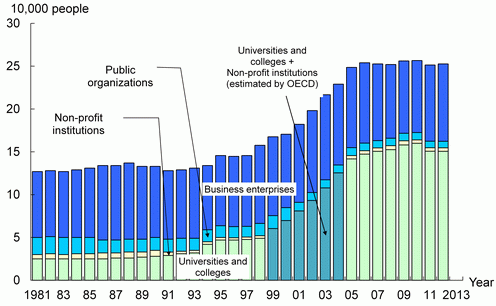
 (H) China
(H) China 
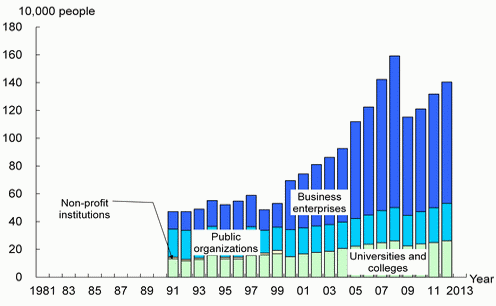
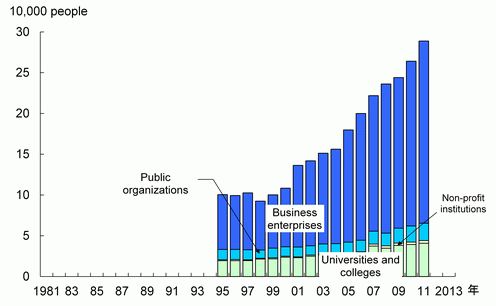
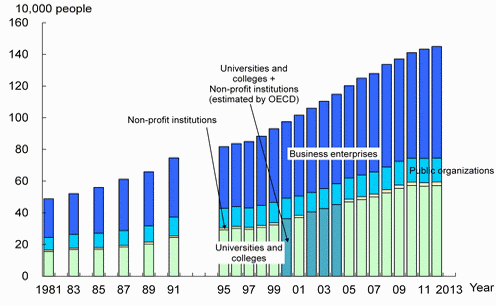
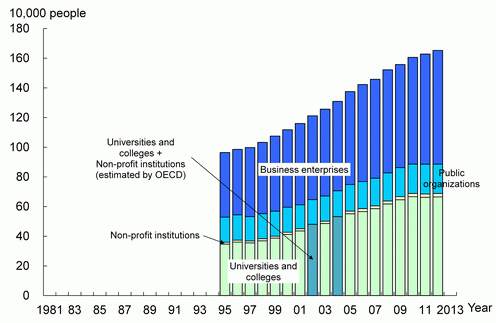
Note:
1) Refer to Chart 2-1-3 for the note on making international comparisons
2) Values for each country are FTE, except Japan, which is HC.
3) The values include the number of researchers in the field of social sciences and humanities (until 2006, only that of the field of natural science and engineering for Korea).
4) Refer to Chart 2-1-3 for the number of researchers in Japan.
5) Germany represents the former West Germany until 1990 and unified Germany since 1991 respectively. Figures for the latest available year are national projections or estimated values.
6) For France, the U.K., China, Korea and the EU, the number of researchers in the non-profit institutions sector was obtained by subtracting the number of researchers in the business enterprises sector; the universities and colleges sector; and public organizations sector from the total.
7) Through 2008, the definition of researcher used in China was not in complete accordance with the OECD. The measurement method was changed in 2009. Caution is therefore necessary when observing changes over time.
8) Figures for the latest available year for the U.K. are provisional; figures for the EU are OECD Secretariat estimates/projections based on each country's materials.
Source:
<Japan> Ministry of Internal Affairs and Communications, “Report on the Survey of Research and Development “; MEXT, “Survey on the data for full-time equivalents in universities and colleges” (2002 and 2008)
<Germany> Bundesministerium fur Bildung und Forschung, “Bundesbericht Forschung 1996, 2000, 2004” ; “Forschung und Innovation in Deutschland 2007” “Bundesbericht Forschung und Innovation, 2008, 2010, 2012” ; OECD, “Main Science and Technology Indicators 2013/2” since 2010.
<U.S. France, U.K., China, and EU> OECD, “Main Science and Technology Indicators 2013/2”
(2) Researchers with doctoral degrees in Japan
As discussed in 2.1.1 above, the definition of researcher for each country does not require any special scientific qualifications. Depending on the country, however, the definition of researcher may include clear conditions such as “specialist knowledge at least equivalent to that of a holder of a doctoral or higher degree.” Examination of the number of researchers with doctoral degrees may be one indicator for looking at the number of researchers with advanced knowledge.
Looking at the state of Japanese researchers with doctoral degrees (Chart 2-1-8 (A)), they numbered 164,000 in 2013. The universities and colleges sector accounted for the largest number of these researchers. The trend in that sector is upward. The smallest number of such researchers was found in the non-profit institutions sector, but that sector has fewer researchers than the other sectors do. While the shares of business enterprises and public organizations are also small, they are showing gradual increases when viewed over the long term.
As for the percentage of researchers (not including current enrollees in doctoral courses) in each sector with doctoral degrees (Chart 2-1-8 (B)), in 2013 the overall figure was 20.8%. By sector, the percentage was highest in the universities and colleges sector, at 56.7% in 2013. It was followed by the public organizations sector at 44.8%. The trend is rising in both sectors. The percentage of doctorate holders of non-profit institutions is also showing considerable growth. The business enterprises sector has the lowest percentage of researchers with doctorates, at just 4.3% in 2013. The trend is flat, with little change since 2002.
(A) Changes in the number of doctorate holders
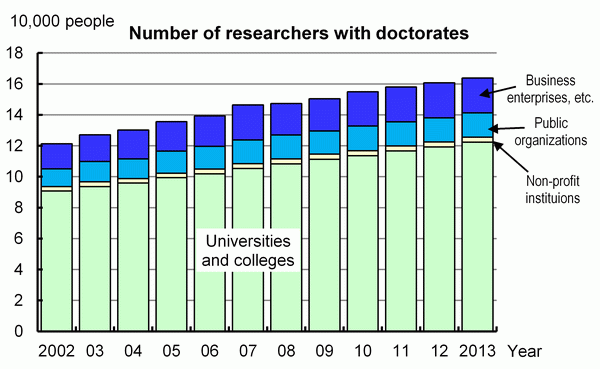
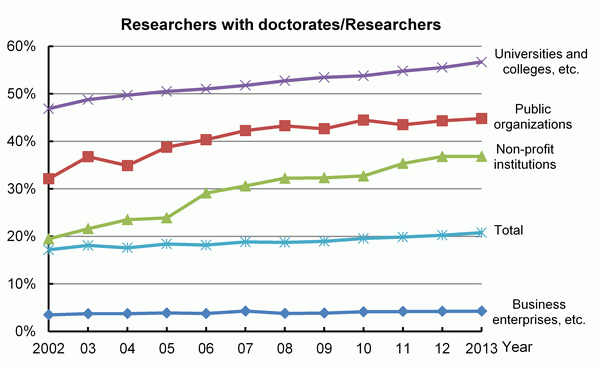
Note:
The universities and colleges sector includes “teachers” and “medical staff and others.” It does not include “doctoral course students in graduate schools.” It also excludes people engaged in research under external and non-regular conditions.
Source:
Ministry of Internal Affairs and Communications, “Report on the Survey of Research and Development”
Column: Circumstances of researchers who hold doctorates in American and Japanese business enterprises
The number of people who have acquired doctoral degrees among researchers serves as an indicator for measuring the number of researchers with advanced knowledge. Although the Japanese Science and Technology Indicators provides the number of people who hold doctorates among researchers(4) in the case of Japan, similar data on other countries and regions had been available. However, efforts to collect data on the acquirement of academic degrees within R&D statistics for business enterprises in the U.S. have started, which has made it possible to obtain data on doctorate holders.
Within the range that is possible, this column examines the circumstances of researchers who hold doctorates in American and Japanese business enterprises.
Doctorate holders among researchers in business enterprises
For years, the National Science Foundation (NSF) of the U.S. has conducted a questionnaire survey(5) that targets business enterprises. However, in 2008 it began executing a more detailed survey called the “Business R&D and Innovation Survey” (ERDIS).
BRDIS measures the number of “R&D employees” in business enterprises (Chart 2-1-9). Here, “R&D employees” refers to “all employees who work on R&D or who provide direct support to R&D (such as researchers, R&D managers, technicians, clerical staff, and others assigned to R&D groups).(6)
“R&D employees” is largely classified into three categories. Of these, one is “R&D scientists & engineers & their managers.” Of the three categories, the only one in which the number of “doctorate holders” is ascertained is “R&D scientists & engineers & their managers.” The number of “doctorate holders” was 123,000 in 2010.
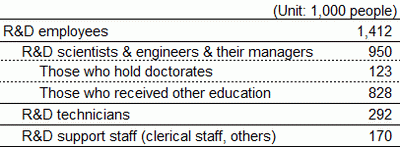
Note:
Values are actual numbers (HC). Totals may not match due to rounding off of figures.
Source:
NSF, “Business Research and Development and Innovation: 2008-10”
Next is a comparison of the circumstances of the number doctorate holders among researchers in business enterprises in Japan and the U.S (Chart 2-1-10).
It should be noted that, in the case of BRDIS, the FTE (full-time equivalents) of “R&D scientists & engineers” are also measured, and the resulting numerical value is mentioned in OECD materials as the number of researchers in American business enterprises.
However, because no numerical value for doctorate holders exists within “R&D scientists & engineers (FTE),” comparison is made using the percentage of the number of doctorate holders in “R&D scientists & engineers & their managers.”
The percentage of researchers who held doctoral degrees in Japanese business enterprises in 2010 was 4%, while that for US business enterprises was 13%, which is approximately three times more.
in Japanese and American business enterprises (2010)
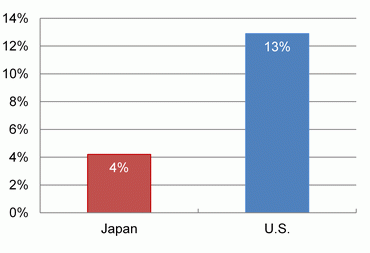
Note:
U.S. researchers are “R&D scientists & engineers & their managers.”
Sources:
For the U.S., same as for Table 2-1-9. For Japan, same as for Table 2-1-8.
Doctorate holders by enterprise size
Next is an examination of how percentages of doctorate holders changes according to enterprise size.
BRDIS of the U.S. determines enterprise size based on number of employees, which makes it possible to acquire data for a variety of workforce sizes. On the other hand, in the case of Japan, enterprise size is set based on capital stock, and therefore the scope of data differs with the U.S. in terms of workforce size. Consequently, conditions cannot be perfectly lined up for Japan-U.S. comparison. Nonetheless, the author makes the following comparison within the scope that is possible.
First, the author divided Japanese business enterprises into small and medium-size enterprises (SMEs) and other enterprises (for the definition of Japanese SMEs, see the note of Chart 2-1-11). Then, for American business enterprises, the author defined “enterprises with between 5 and 249 employees” as SMEs and “enterprises with at least 250 employees” as other enterprises.
A look at the percentages of the numbers of doctorate holders among researchers in each enterprise size (Chart 2-1-11) shoes that, in 2010, the percentages for SMEs and other enterprises in Japan were equal. On the other hand, in the case of the U.S., the percentage of doctorate holders in SMEs was higher than that for other enterprises.
(A) Percentage of doctorate holders among researchers
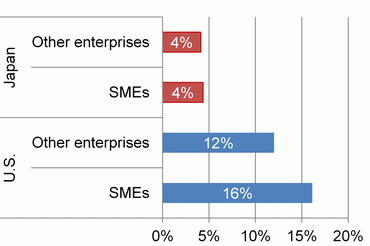
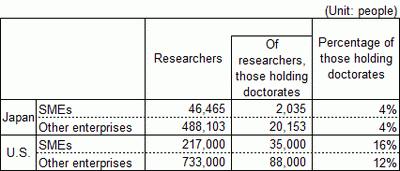
Notes:
<Japan>
“SME” as it is used here refers only to those enterprises that fall into the SME classification; said enterprises must meet the following conditions (based on the Small and Medium Enterprises Basic Act):
• Enterprises engaged in manufacturing, construction, transport/postal services, or any other category of business (excluding those mentioned below): Capital of no more than 300 million yen and workforce of no more than 300 employees.
• Wholesale trade: Capital of no more than 100 million yen and workforce of no more than 100 employees.
• Scientific research, professional and technical services, unclassified other services: Capital of no more than 50 million yen and workforce of no more than 100 employees.
• Stratification is not used for workforce size.
<U.S.>
1) “SME” as it is used here refers to “enterprises with between 5 and 249 employees” and “other enterprises” refers to “enterprises with at least 250 employees.”
2) U.S. researchers are “R&D scientists & engineers & their managers.”
Sources:
<Japan> Ministry of Internal Affairs and Communications, “Report on the Survey of Research and Development”
<U.S.> NSF, “Business Research and Development and Innovation: 2008-10”
Summary
The U.S. has a larger percentage of doctorate holders among researchers in its business enterprises than Japan. Moreover, in the U.S., smaller enterprises have a larger percentage of doctorate holders among their researchers.
This suggests that American business enterprises utilize human resources with advanced knowledge more than Japanese enterprises. As this trend is evident even among smaller enterprises, this indicates that more people with advanced knowledge are active in American business enterprises.
(Yumiko Kanda)
2.1.4 Female researchers in each country
In this section, the ratio of female researchers in each country is examined. The active role of female researchers is expected from the viewpoint of the diversity of researchers. Furthermore, promotion of the activities of female researchers has been one of basic policies of the Science and Technology Basic Plans since the first plan. The ratio of the number of female researchers against the total was measured using HC values. No precise figures on the number of female researchers exist for the U.S. Figures for the U.K. are estimates by that country.
The ratio of the number of female researchers against the total in Japan was 14.4% in 2013. This ratio was the smallest among the surveyed countries; however, in terms of number, Japan ranked behind the U.K., Russia, and Germany. (Chart 2-1-9).
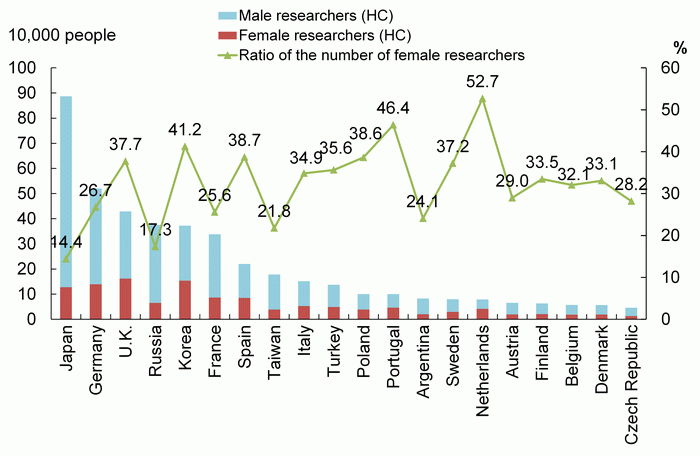
Notes:
1) Data are from the following years: Japan: 2013; Russia and Taiwan: 2012: all other countries and regions: 2011.
2) Values are on a head count basis.
3) Data for the U.S. and China are not included in materials below.
4) Values for Russia and France are underestimated or based on underestimated data.
Sources:
<Japan> Ministry of Internal Affairs and Communications, “Report on the Survey of Research and Development”
<Others> OECD, “Main Science and Technology Indicators 2013/2”
What differences come to light when looking at the proportions of the number of female researchers by sector in the various countries? The ratio of female researchers against the total by sector was examined for selected countries where data was available (Chart 2-1-13).
In each country, the ratio of female researchers was small in the business enterprises sector. The ratio was relatively large in the universities and colleges sector in each country.
In Japan, the number of female researchers in the universities and colleges sector accounted for a large proportion of the total at 25.0% in 2013. On the other hand, the share of female researchers in the business enterprises sector was smallest, accounting for 8.0% of the total. Additionally, Japan's share of female researches in the non-profit institutions sector is small compared to the selected countries.
In Germany, data for the public organizations sector and for the non-profit institutions sector were combined. A look at 2011 values shows that the two sectors of universities and colleges and public organizations/non-profit institutions have large percentages of 36.3% and 33.5%, respectively.
In France, the largest percentage belongs to the non-profit institutions sector, which accounts for 42.0%, followed by the public organizations sector with 35.0%.
In the U.K., the largest percentage belongs to the universities and colleges sector, which accounts for 44.4%, followed by the non-profit institutions sector with 40.5%.
And in Korea, the non-profit institutions sector has the largest percentage with 32.9%, followed by the universities and colleges sector with 27.3%.
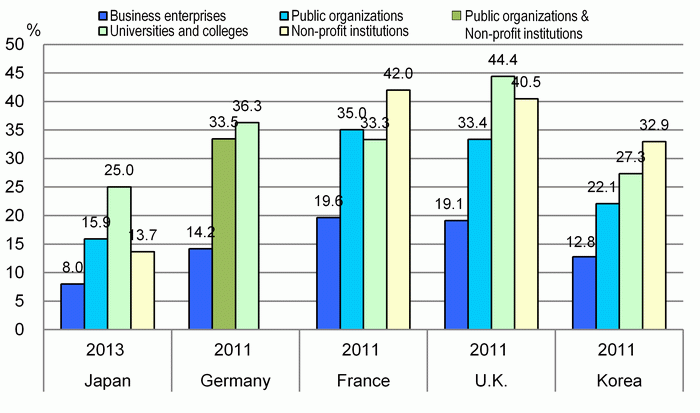
Notes:
1) Values for France's public organizations sector are underestimated or based on underestimated data.
2) For the non-profit institutions sectors of France, the U.K., and Korea, the number of researchers was obtained by subtracting the numbers of researchers in the business enterprises sector, the universities and colleges sector, and public organizations sector from the total.
Sources:
<Japan> Ministry of Internal Affairs and Communications, “Report on the Survey of Research and Development”
<Other countries> OECD “Main Science and Technology Indicators 2013/2”
Next, the number of female researchers in Japan and their ratio to the total number of researchers was examined (Chart 2-1-14). The number of female researchers as of 2013 was 127,836. This shows a fairly consistent growth trend. The same is true for percentage.
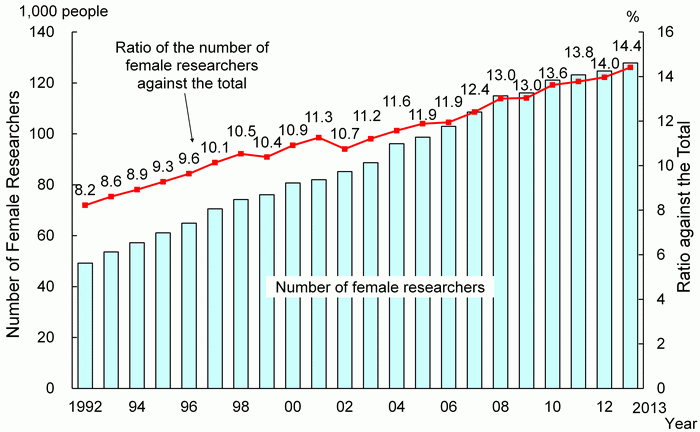
Note:
The ratios of the number of female researchers published in the “Report on the Survey of Research and Development” by the Ministry of Internal Affairs and Communications were used. The numbers of researchers until 2001 in this chart were obtained by measuring only regular researchers in the business enterprises sector and the non-profit institutions sector, and those including external non-regular researchers in the universities and colleges sector.
Source:
Ministry of Internal Affairs and Communications, “Report on the Survey of Research and Development”
2.1.5 Mobility of researchers
The enhancement of mobility among researchers is thought to encourage more active use of the abilities of researchers, who are ultimately in charge of knowledge production, and simultaneously to develop a research environment with vitality in each workplace.
(1) Birthplaces of doctoral degree holders in the U.S.
The number of foreign researchers can be considered an indicator of researcher mobility and internationalism. However, the number of foreign researchers is not calculated in the case of Japan. Likewise, in the U.S., although data are available on foreigners when looking at “scientists and engineers” as an occupational classification, no figures are available on “researchers” in the narrow sense. This section will therefore look at foreigners among people holding doctoral degrees in the U.S., a situation for which data exist.
Of the 1.30 million people obtaining doctoral degrees in the U.S. in 2010, 470,000, 36.6%, were foreign nationals (Chart 2-1-15). Looking at a breakdown of science and engineering-related fields, engineering had the highest percentage of foreign nationals at 56.5%. The computers/mathematics field also has a high percentage with 51.7%.
Turning next to the countries and regions doctoral degree holders in the U.S. come from and the fields they are employed in (Chart 2-1-16), 28.2% of those employed come from outside the U.S. People from Asia are the most common, accounting for 18.7% of employed holders of doctoral degrees.
Looking at individual occupational fields, that with the largest percentage of people from Asia is engineering with a 40.1% share. The computer and information scientist field also has a high percentage of people from Asia with 35.8%.
In the U.S., a large percentage of the people holding doctoral degrees in engineering and in computer science and mathematics are foreign nationals, and a large percentage is employed in the U.S.
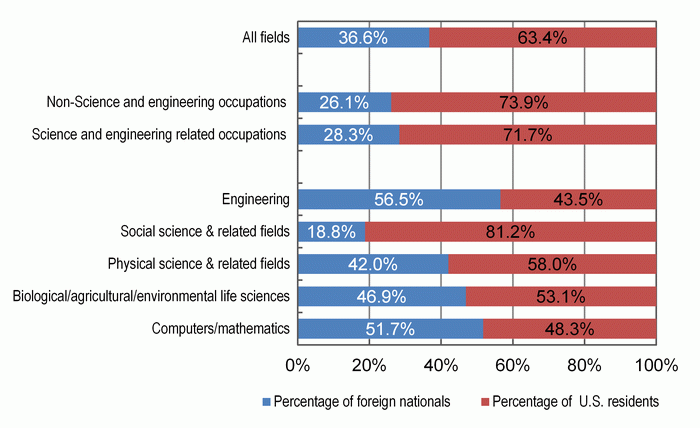
Sources:
NSF, “SESTAT Public 2010” website.
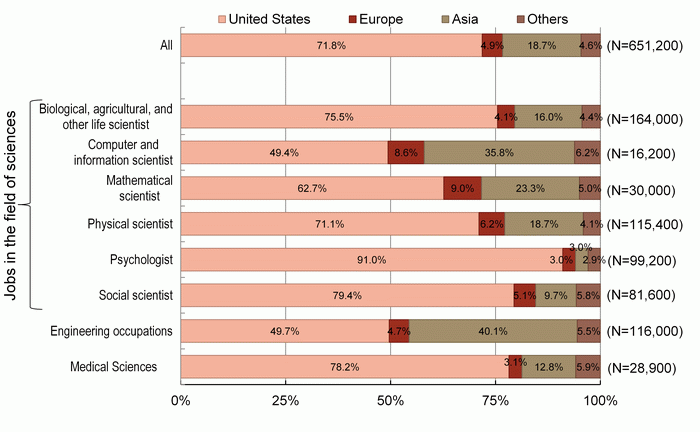
Note:
“Kagaku kogakuk” is the Japanese translation of “science and engineering.”
Source:
NSF, “Characteristics of Doctoral Scientists and Engineers in the United States: 2008”
(2) Percentage of postdoctoral fellows who are foreign nationals
Next, the percentage of postdoctoral fellows who are foreign nationals is examined. Chart 2-1-17 shows the percentages of postdoctoral fellows in Japan's universities and colleges sector and public organizations sector who are foreign nationals. “Field” as discussed here refers to the primary research fields of the laboratories with which the postdoctoral fellows are affiliated.
The overall percentage of foreign nationals is 23.2%. By sector, engineering has the largest percentage at 37.5%, followed by the physical sciences and agriculture sectors at 19.1% each.
at Japanese universities and public organizations (as of November 2009)
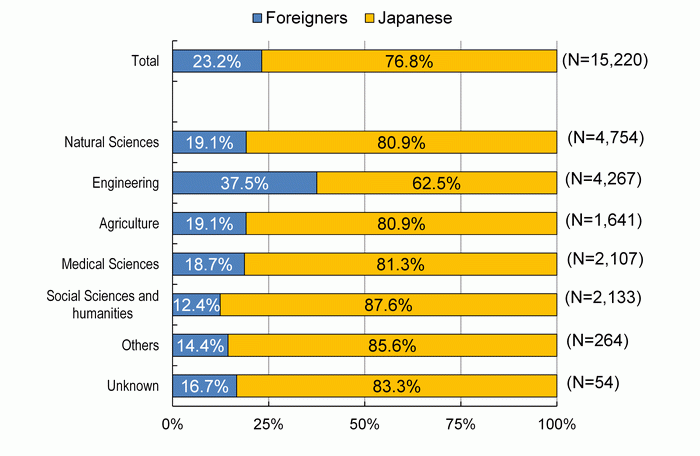
Note:
1) “Postdoctoral fellow” as used here refers to a person with a doctoral degree hired for a fixed term who 1) is engaged in research work in a research institution at a university, etc., but who does not have the status of professor, associate professor, assistant professor, lecturer, etc., or 2) is engaged in research work in a research institution in an independent administrative agency, etc., but who is not a team leader, senior research fellow, etc., of his or her research group. (This includes so-called ABDs who have obtained the required number of credits and conditionally withdrawn from school.)
2) Research fields are the primary fields of the postdoctoral fellows' affiliated laboratories.
Source:
NISTEP, “Survey on Postdoctoral Fellows Regarding Employment and Moving-out Situations: Complete Survey for Universities and Public Research Institutes in Japan (FY 2009 Data)” (Research Material No. 202)
Chart 2-1-18 shows the percentage of postdoctoral fellows in the U.S. who are foreign nationals (temporary visa holders). “Field” here refers to the fields of the institutions with which the postdoctoral fellows are affiliated.
Overall, more than half of U.S. postdoctoral fellows, 52.0%, are foreign nationals. By sector, the highest percentage is in engineering at 59.7%, and the second highest is in physics at 58.4%.
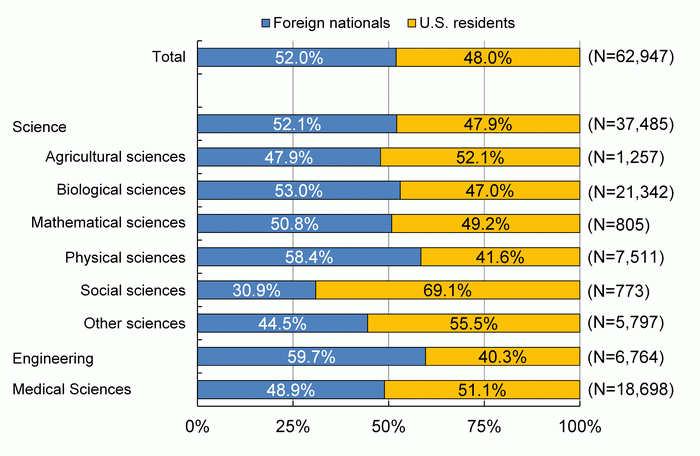
Notes:
1) “Foreign nationals” here refers to temporary visa holders. “U.S. residents” refers to U.S. citizens and permanent residents.
2) “Postdoctoral fellow” as used here refers to a person meeting both of the following qualifications.
(i) A person who has within the last five years received a PhD or equivalent (e.g., SCD [Doctor of Science] or Deng [Doctor of Engineering]), or a primary professional degree (MD [Doctor of Medicine], DDS [Doctor of Dental Science], DO [Doctor of Osteopathic Medicine/Osteopathy], or DVM [Doctor of Veterinary Medicine]), or a foreign degree equivalent to a U.S. doctoral degree.
(ii) A person who is generally employed for a period from five to seven years, mainly for training in a discipline and in research, and who works under a senior scholar in an assigned unit in an institution.
3) “Research field” refers to the fields of the postdoctoral fellows' affiliated organizations
Source:
NSF-NIH Survey of Graduate Students and Postdoctorates in Science and Engineering: Fall 2011.”
(3) Mobility of Japanese researchers between sectors
The following looks at the circumstances of new graduate employment,(7) entering (8) and exiting (9) a place of employment among Japanese researchers (Chart 2-1-19). The number of researchers hired in Japan in 2013 was 61,114. Of these, 26,630 were new graduate hires and 34,484 were mid-career recruits. The number of researchers who left their place of employment was 54,270. The number of new graduates employed had been declining since peaking in 2009; however, it grew by 2.7% compared to the previous year in 2013.
By sector, in the business enterprises sector, new graduates employed had consistently outnumbered mid-career recruits; however, mid-career recruits have outnumbered new graduates since 2011. Additionally, the number of new graduates employed had been declining since peaking in 2009; however, it grew by 2.8% compared to the previous year in 2013.
In the non-profit institutions/public organizations sector, the numbers of mid-career recruits and mid-term transfers is larger than that for new graduates employed. Over the long term, the number of mid-term transfers has been falling since the mid-2000s, while that for mid-career recruits has been in a long-term decline.
In the universities and colleges sector, the numbers of mid-career recruits and midterm transfers are larger than that for new graduates employed. The numbers of mid-career recruits and midterm transfers in the universities and colleges sector had been increasing until around 2008, but have been flat since then. However, in recent years, the number of mid-term transfers has been on an upward trend.
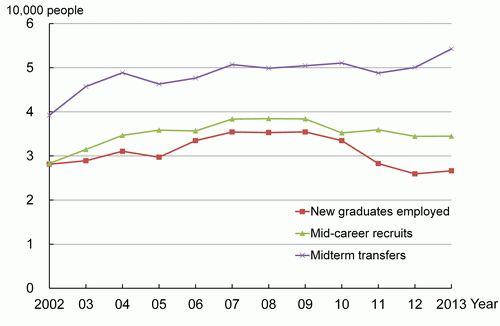
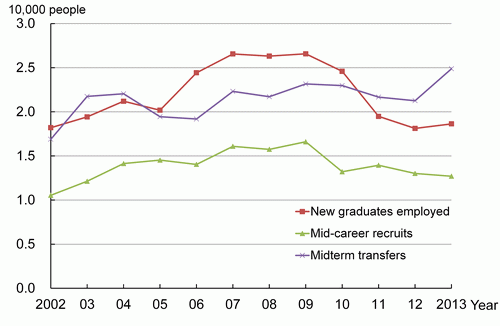
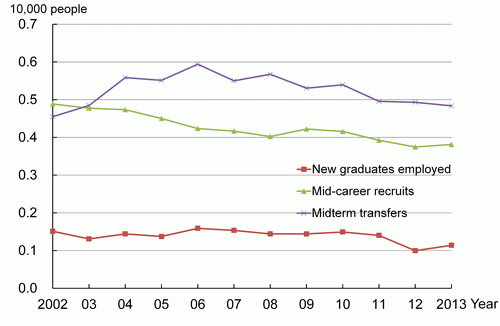
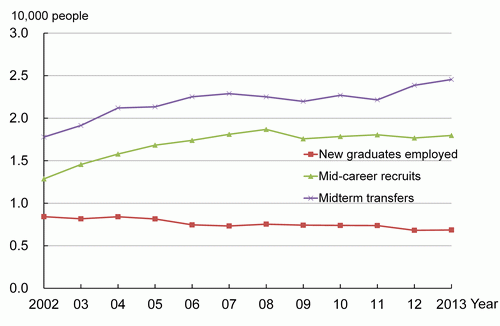
Note:
Up to 2011,” business enterprises” refers to “companies” and “special and public administrative corporations” (non-profit). From 2012 it refers to “companies” only.
Source:
Ministry of Internal Affairs and Communications, “Report on the Survey of Research and Development”
The following examines the sectors of origin of researchers who were mid-career recruits by comparing data from 2002 with that from the latest available year (Chart 2-1-20).
In 2013, a very large percentage, 93.9%, of researchers transferring in the business enterprises sector came from other business enterprises. This percentage remains roughly unchanged in comparison with 2003. It should be noted that 36.3% transferred from parent enterprises; this percentage is roughly the same as that for 2003.
In the non-profit institutions and public organizations sector, researchers transferring within the sector accounted for the largest percentage at 54.5%. Compared to 2003, this was an increase of 1.9 percentage points. On the other hand, the percentage of researchers transferring from business enterprises was 20.1%, which represents a decrease of 6.3 percentage points from 2003.
In the universities and colleges sector, 41.9% of researchers transferred from the same sector. However, many also transferred from other sectors, as 39.7% came from the non-profit institutions/public organizations sector, a figure that is roughly equivalent to the percentage coming from the same sector. In the case of the universities and colleges sector, the percentage of researchers transferring from the non-profit institutions/public organizations sector is large and growing.
For the business enterprises sector and non-profit institutions/public organizations sector, the numbers of researchers transferring from other sectors is decreasing, while that for researchers transferring from the same sector is increasing.
It would thus be difficult to assert that mobility among sectors is increasing.
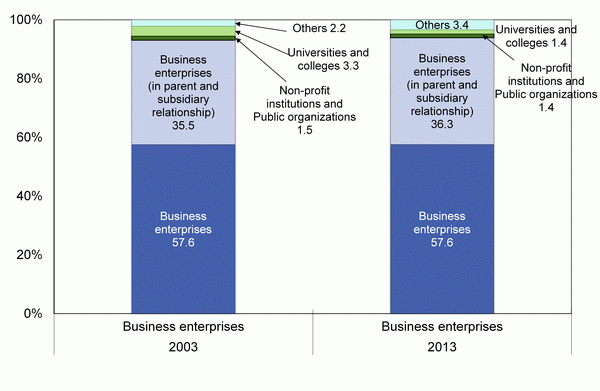
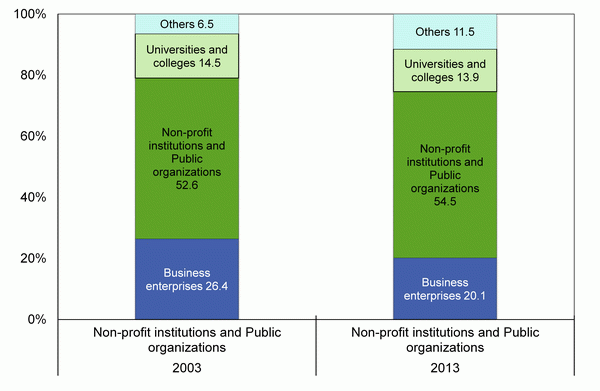
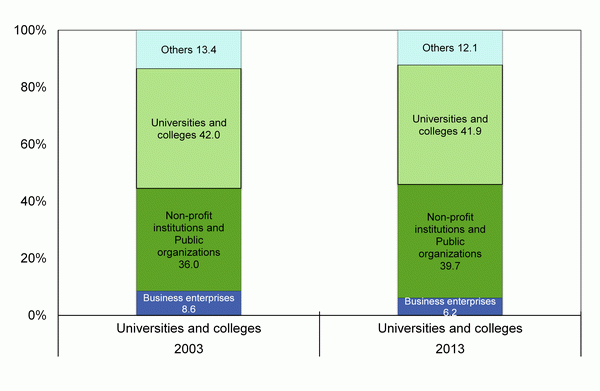
Note:
Same as for Chart 2-1-19.
Source:
Ministry of Internal Affairs and Communications, “Report on the Survey of Research and Development”
(1) In Japan the definition of a “researcher” is based on the terms pro-vided in the “Report on the Survey of Research and Development” issued by the Ministry of Internal Affairs and Communications. In the statistics of this Ministry, the field of “research” is classified into “basic research” , “applied research” , and “development” and the “regular researchers” conducting such research are considered to be quite close to the “R&D scientists and engineers” mentioned in the Frascati Manual.
(2) For example, for researchers working at higher educational institutes such as universities and colleges, there are many cases when they are engaged in education together with their research work. The way to measure the manpower of the portion of activities engaged in actual research work rather than treating above mentioned kinds of researchers (called “part-time researchers” ) as the same level as “full-time research-ers” is called the “full-time equivalent” . Specifically, for example, if a researcher dedicates 60% of his/or her working time to R&D activities on annual basis, the value for this person as a researcher would be “0.6 people” .
(3) In 1975, the OECD issued a recommendation that the full-time equivalent method should be applied to measure the manpower of researchers who are hired. The majority of OECD member countries have adopted the FTE method. The necessity of the FTE method and its principles are provided in the Frascati Manual issued by the OECD, which also provides international standards on the surveying methods for R&D statistics. The 2002 edition advises using both the HC and FTE methods.
(4) Refer to Chart 2-1-8.
(5) Up until 2007, the survey was called the “Survey of Industrial Research and Development.”
(6) R&D employees exclude employees who provide indirect support to R&D, such as corporate personnel, security guards, and cafeteria workers.
(7) New graduate employment refers to so-called new university graduates. Casual and part time workers are included only if they have completed school and have experience as temporary workers at universities or research institutes. Researchers hired for fixed terms are considered new graduate employees if the term is at least nine months.
(8) People coming from outside the organization (not including new gradu-ate hires)
(9) People exiting employment in a workplace include retirees.



